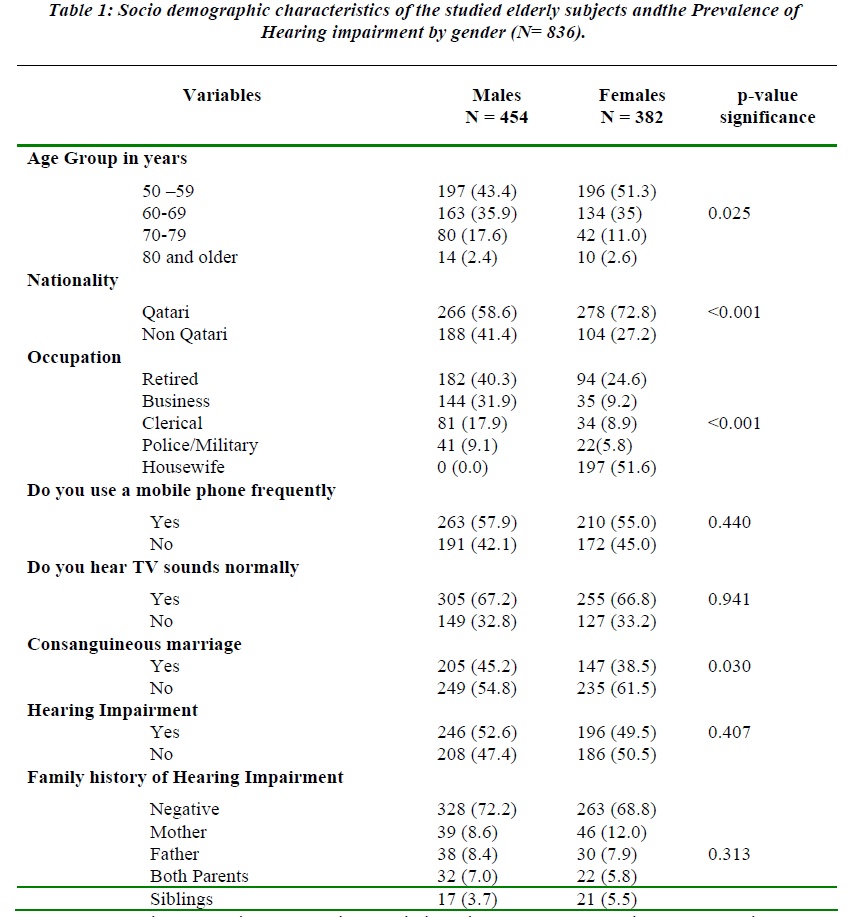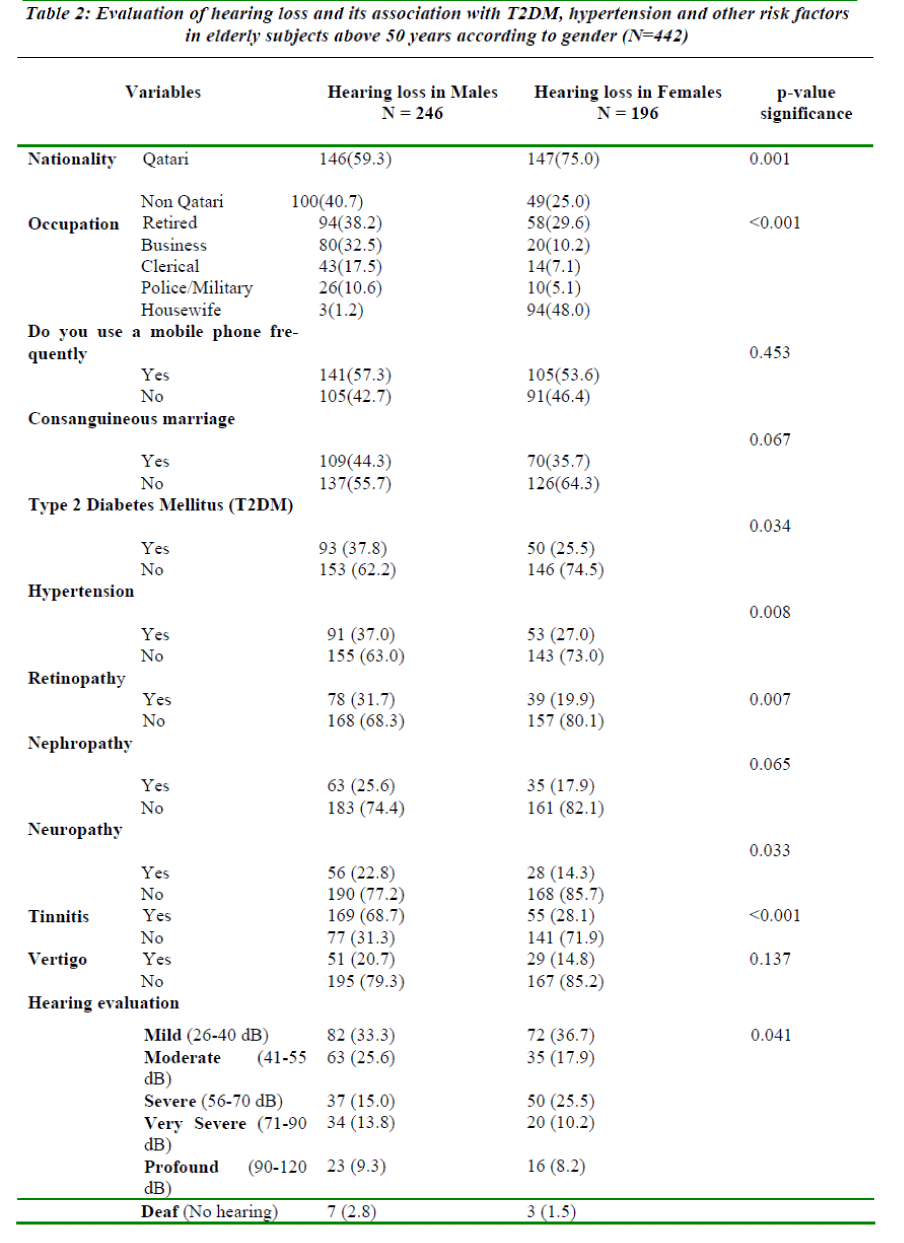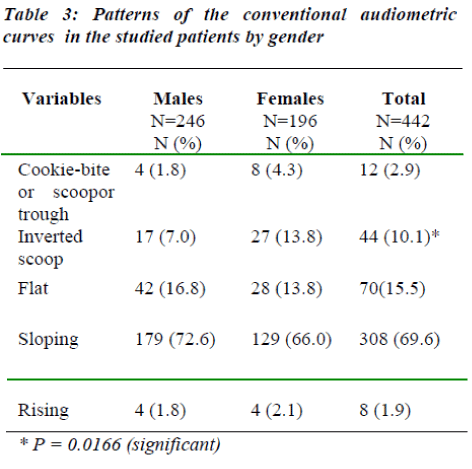ISSN: 0970-938X (Print) | 0976-1683 (Electronic)
Biomedical Research
An International Journal of Medical Sciences
- Biomedical Research (2008) Volume 19, Issue 3
Association between hearing loss and Type 2 Diabetes Mellitus in elderly people in a newly developed society
Abdulbari Bener 1, *, Ahmad H. A. Salahaldin3, Sara M. Darwish4 , Abdulla O.A.A. Al-Hamaq 5 , Loida Gansan 3
1Department of Medical Statistics & Epidemiology, Hamad General Hospital and Hamad Medical Corporation, State of Qatar
2Department Evidence for Population Health Unit, School of Epidemiology and Health Sciences, The University of Manchester, Manchester, UK
3Department of ENT, Audiology Unit, Rumailah Hospital & Hamad General Hospital, Hamad Medical Corpora-tion, State of Qatar.
4Department of Endocrinology, Hamad General Hospital, Hamad Medical Corporation, State of Qatar.
5Qatar Diabetic Associations and Qatar Foundation, Doha, State of Qatar.
- *Corresponding Author:
- Abdulbari Bener
Department of Medical Statistics & Epidemiology
Hamad General Hospital, Hamad Medical Corporation
Weill Cornell Medical College
PO Box 3050,
Doha, State Qatar
Office Tel: 974- 439 3765
Office Tel: 974- 439 3766
Fax: 974-439 3769
E-mail: abener@hmc.org.qa
E-mail: abaribener@hotmail.com
Accepted date: September 4 2008
Keywords
Epidemiology. Hearing loss. Elder age. Medical condition, Hearing loss evaluation.
Introduction
Hearing loss is a common consequence of aging [1-5]. It is difficult to distinguish changes of normal aging from those of other contributing factors. Hearing impairment is one of the most important health problems of the elderly above 60 years [1-7]. It has been reported that hearing loss ranks as the third-most-prevalent major chronic dis-ability in elderly and the prevalence of hearing loss has been documented very well by several authors [1-5,7-21].
Unfortunately, hearing impairments often receive mini-mal attention. Hearing loss can affect the most common and simple tasks of daily life [5-9]. The relation between hearing loss and other various health conditions and ac-tivity limitations among older people is well documented [1-17], but no any study has been conducted on this topic in the oil-rich Arabian Gulf Countries.
The aim of this study was to determine the prevalence of hearing loss and its association with type 2 diabetes melli-tus in elderly people in a newly developed Arabian soci-ety.
Subjects and Methods
This is a cross-sectional study design which was con-ducted during the period from January 2003 to November 2006 in the outpatient clinics of the Hamad Medical Cor-poration. The study target population included all pa-tients aged 50 years and above who were visiting endo-crinology outpatient clinic and referred to the ENT clinic for screening. Over all, out of 1,000 subjects, 836 (83.6%) subjects gave consent to participate in the pre-sent study. 16.4% who did not participate was due to in-ability to attend the scheduled appointments, lost follow-up, lack of time and lack of interest. Data were recorded on consanguinity, family history of hearing impairment, T2DM, retinopathy, nephropathy, and neuropathy from patients’ medical records.
Persons were classified as diabetic if they were currently taking diabetic medication. We studied all subjects diag-nosed for type T2DM in accordance with the established diagnostic criteria by American Diabetes Association [18-19]. The degree of blood sugar level in our patient popu-lation was 10.61± 3.26 (mean± S.D).
Hearing evaluation procedures:
All patients were tested by pre-trained technicians using two clinical digital audiometers (Garson Stadler GSI 61 and Madsen Orbitar 922 which are regularly calibrated to international standards) in a quiet room. Hearing impair-ment was defined as the inability to hear a tone of 40 dB or grater at 2,000 Hz frequency in the better ear. This conservative cut point was chosen because 2,000 Hz falls within the auditory frequency range most important for speech discrimination. Hearing loss evaluation described as follows: normal (<25 dB); mild (26-40 dB); moderate (41-55 dB); severe (56-70 dB); very severe (71-90 dB); profound (91-120 dB); and deaf (no hearing).
Fisher exact and chi-square tests were used to compare frequencies between two or more than two categorical variables. The level p<0.05 was taken as the cutoff value for significance.
Results
Table 1 shows the socio-demographic characteristics of the studied elderly subjects above 50 years and the preva-lence of hearing loss by gender. Majority of the studied male and female patients were in the age group (50 – 59) (43.4% vs 51.3%). Over 55% of the studied patients were using mobile phones frequently. The consanguineous marriages were observed higher in males (45.2%) than in females (38.5%). The prevalence of hearing impairment was higher among males (52.6%) than in females (49.5%).
Table 2 presents the evaluation of the hearing loss by gender and its association with T2DM, and other risk fac-tors in elderly subjects above 50 years according to gen-der. The prevalence of hearing impairment was higher in Qataris (66.3%) than in non-Qataris (33.7%). 40.5% of the studied subjects were consanguineously married cou-ples. Socio-economic status showed that majority of the subjects belonged to retired group (34.4%) and 22.6% were business men. The hearing impairment was very severe in Qatari women (75%) than in men (59.3%). Very severe (71 – 90 dB) and profound (90 – 120 dB) cases were found more in men (13.8% & 9.3%) than in women (10.2% & 8.2%). Also deafness was more preva-lent in males (2.8%) than in females (1.5%). As hearing became worse in men, the associated risk factors were higher in men such as T2DM (37.8% & 25.5%), hyper-tension (37% vs 27%), retinopathy (31.7% vs 19.9%), Nephropathy (25.6% vs 17.9%), Neuropathy (22.8% vs 14.3%), Tinnitis (68.7% vs 28.1%), Vertigo (20.7% vs 14.8%) than in women. There was a statistically signifi-cant relationship between men and women in all the risk factors except for Vertigo and Nephropathy.
Table 3 shows the patterns of the conventional audiometric curves in the studied patients by gender. Sloping audio-metric curves were found to be the most prevalent ones in elderly patients (72.6% for males & 66.0% for females), followed by flat audiogram shape (16.8% for males & 13.8% for females), then inverted scoop (7% for males & 13.8% for females). There was a significant difference found between elderly men and women in inverted scoop audiometric curve (P=0.0166).
Hearing loss among elderly population is a prevalent problem that affects their ability to understand speech in quiet, noise, and reverberation. Elderly people also ex-perience difficulty in understanding rapid speech, heavily accented English language, and speech with few contex-tual cues and/or added memory demands. Hearing prob-lems have a profound influence on the lives of the elderly. Although hearing loss in the elderly may not have a cure, early rehabilitation helps to restore better quality of life, if the problem is detected early.
The prevalence of hearing impairment in the studied sub-jects was higher in males (52.6%) than females (49.5%). Nearly half of the studied elderly patients suffered from hearing loss which is similar to the findings in some other studies [1-8,10-17]. Although comparisons of prevalence rates are difficult because of different methods of assessment and age grouping, the findings of this study are consistent with rates reported elsewhere [1-4,6-8,14-15].
Discussion
Hearing impairment is the fifth most prevalent chronic health condition and the second most prevalent impair-ment in the United States16. Both men and women are at risk for age-related hearing loss. Very severe and pro-found cases were found more in men than in women. Also, deafness was more prevalent in men. It is reported in the US that women of all ages have better hearing than men at frequencies above 2000Hz [22].
Histopathological studies have shown damage to the nerves and vessels of the inner ear of individuals with diabetes [23]. One population-based study [24] has evaluated the association between diabetes and hearing loss. A number of clinical studies have investigated the possible association of diabetes mellitus and hearing loss [25]. Audiometric data obtained in this study revealed that hearing became worse as blood sugar increased in subjects. Also, in our study, a good proportion of the subjects with hearing loss were diabetic (32.4%) and hypertensive (32.6%).
Other associated risk factors in our elderly subjects with hearing loss were tinnitus (50.7%), retinopathy (26.5%), nephropathy (22.2%), neuropathy (19%) and vertigo (18.1%). All the associated risk factors were higher in men and there was a statistically significant relationship in all the risk factors between men and women except for vertigo and nephropathy. A study done by Dalton et al. [26] reported that individuals with T2DM and nephropa-thy were more likely to have hearing loss. The associated complaint of tinnitus was very high in elderly patients with hearing loss. The endolymphatic hydrops complaint was not very common in elderly patients (1.4%).
Overall, around 31.9% had severe hearing loss and nearly 22% had moderate hearing loss which is much lower than the rate reported in a study that 60% of the patients tested at the hearing clinic were found to have severe hearing loss [21]. But in the UK, 8% of the participants reported a severe hearing loss and 42% moderate hearing.
Sloping audiometric curves were found to be the most prevalent ones in elderly subjects (72.6% for males & 66.0% for females), followed by flat audiogram shape (16.8% for males & 13.8% for females). There was a significant difference found between elderly men and women in inverted scoop audiometric curve. Basin (Cookie-bite or scoop or trough) and Rising were the least ones among the audiometric curves in our studied subjects. Most of the audiometric curve patterns found in our patients were demonstrated by Schuknecht [27] in his reports where he described 4 types of pathological changes in presbyacusis and accordingly their presumed audiometric curve patterns; first Sensory presbyacusis with sloping curve, second Neural presbyacusis with ba-sin curve, third Strial presbyacusis with flat audiogram and fourth Cochlear conductive presbyacusis with ski-slope audiogram. Recently, it has been demonstrated an-other mixed form of presbyacusis that involve a mixture of 2 to 4 types of above mentioned curves. Although we have demonstrated most of the curves in our study, it is difficult to determine the effect of diabetes without histo-pathological studies. Yet, the effect of diabetes mellitus on hearing and specially in old population will add to the pathological derangement associated with aging process.
Noise exposure was a main environment factor which was frequently associated with sensorineural hearing loss in our study population. Many elderly people accept their hearing loss, believing there is no effective treatment; other attribute it to the aging process or even deny its ex-istence. Unfortunately many physicians do not view hearing loss as a significant problem and like the patient, often attribute it to normal aging. As reported in many studies, the present study show a strong association be-tween hearing loss and diabetes mellitus in elderly people [28-30].
Limitations
There are some limitations to our study that must be ac-knowledged. Firstly, although the total sample size was appropriate to estimate the prevalence in the population, the desired level of precision was not always obtained for some of the estimates in the age and sex groups. Sec-ondly, despite the acceptable response rate in hearing (83.6%), the prevalence of hearing loss may have been overestimated assuming that those not examined may have been less likely to be suffering from impaired hear-ing or vision. Thirdly, study was carried out hospital population based sample of Qatari’s population with spe-cial socioeconomic characteristics so that we cannot ex-trapolate the results to the whole population of the coun-try. Finally, this study highlights the need to target intervention programmes for prevention of hearing impair-ment to elderly people and those with little or no educa-tion as the high-risk groups.
Conclusion
The study finding revealed that the prevalence of hearing loss was higher in men than in women. Also, the hearing impairment was higher in Qataris than in non-Qataris . Nearly half of the studied subjects were consanguineously married couples. Also, the results provided an additional evidence that hearing impairments is associated with dia-betic mellitus type 2 and have significant negative impact on quality of life older persons. Sloping audiometric curves were found to be the most prevalent ones in eld-erly subjects, followed by flat audiogram shape.
Acknowledgement
The project was supported and funded by the Diabetic Association and Qatar Foundation for generous support and help while this project conducted.
References
- Wallhagen MI, Strawbridge WJ, Cohen RD, Kaplan GA. An increasing prevalence of hearing impairment and associated risk factors over three decades of the Alameda County Study. Am J Public Health. 1997; 87: 440-442.
- Cruickshanks KJ, Wiley TL, Tweed TS, Klein BE, Klein R, Mares-Perlman JA, Nondahl DM. Prevalence of hearing loss in older adults in Beaver Dam, Wiscon-sin. The Epidemiology of Hearing Loss Study. Am J Epidemiol 1998; 148: 879-886.
- Lim JK, Yap KB. Screening for hearing impairment in hospitalized elderly. Ann Acad Med Singapore 2000; 29: 237-241
- Megighian D, Savastano M, Salvador L, Frigo A, Bol-zan M. Audiometric and epidemiological analysis of elderly in the Veneto region. Gerontology. 2000; 46: 199-204.
- Campbell VA, Crews JE, Moriarty DG, Zack MM, Blackman DK. Surveillance for sensory impairment, activity limitation, and health-related quality of life among older adults--United States, 1993-1997. MMWR CDC Surveill Summ. 1999; 48: 131-156.
- Loh KY, Elango S. Hearing impairment in the elderly. Med J Malaysia. 2005; 60: 526-529.
- Maggi S, Minicuci N, Martini A, Langlois J, Siviero P, Pavan M, Enzi G. Prevalence rates of hearing impair-ment and comorbid conditions in older people: the Ve-neto Study.J Am Geriatr Soc 1998; 46: 1069-1074.
- Crews JE, Campbell VA. Vision impairment and hear-ing loss among community-dwelling older Americans: implications for health and functioning. Am J Public Health. 2004; 94: 823-829
- Dalton DS, Cruickshanks KJ, Klein BE, Klein R, Wiley TL, Nondahl DM. The impact of hearing loss on quality of life in older adults.Gerontologist. 2003; 43: 661-668.
- Nondahl DM, Cruickshanks KJ, Wiley TL, Klein R, Klein BE, Tweed TS. Prevalence and 5-year incidence of tinnitus among older adults: the epidemiology of hearing loss study. J Am Acad Audiol 2002; 13: 323-331.
- www.globalaging.org/health/us/hearingloss.htm (ac-cessed on 17/10/2006)
- Mills R. The auditory system. In : Pathy MSJ. Princi-ples and practice of geriatric medicine. 2nd Edition. London: John Wiley, 1991
- Reuben DB, Walsh K, Moore AA, Damesyn M, Green-dale GA. Hearing loss in community-dwelling older persons: national prevalence data and identification us-ing simple questions. J Am Geriatr Soc 1998; 46: 1008-1011.
- Gussekloo J, de Bont LE, von Faber M, Eekhof JA, de Laat JA, Hulshof JH, van Dongen E, Westendorp RG. Auditory rehabilitation of older people from the gen-eral population--the Leiden 85-plus study. Br J Gen Pract. 2003; 53: 536-540.
- Gerson LW, Jarjoura D, McCord G. Risk of imbalance in elderly people with impaired hearing or vision. Age Ageing 1989; 18: 31-34.
- Jee J, Wang JJ, Rose KA, Lindley R, Landau P, Mitchell P. Vision and hearing impairment in aged care clients. Ophthalmic Epidemiol. 2005; 12: 199-205.
- Herbsi KG, Humphrey C. Prevalence of hearing im-pairment in the elderly living at home. J R Coll Gen Pract 1981; 31: 155-160.
- American Diabetes Association. Diagnosis classifica-tion of diabetes mellitus. Diabetes Care 2004; 27: S5-S10.
- Alberti KG, Zimmet PZ.Definition, diagnosis and clas-sification of diabetes mellitus and its complications. Part 1: diagnosis and classification of diabetes mellitus provisional report of a WHO consultation. Diabet Med 1998; 15: 539-553.
- Murphy MP, Gates GA, Hearing Loss: Does Gender Play a Role? Medscape Womens Health 1997; 2: 2.
- Sangster JF, Gerace TM, Seewald RC, Hearing loss in elderly patients in a family practice. Can Med Assoc J 1991; 144: 981-984.
- Kochkin S. Marke Trak VI: On the issue of value : Hearing aid benefit, price, satisfaction and brand repur-chase rates. Hearing Rev 2003;10: 12-26.
- Wackyam PA, Linthicum FH. Diabetes mellitus and hearing loss: clinical and histopathologic relationships. Am J Otol 7: 176-182, 1986.
- Gates G A, Cobb JL, D’Agostino RB, Wolf PA: The relation of hearing in the elderly to the presence of car-diovascular disease and cardiovascular risk factors. Arch Otolaryngol Head Neck Sug.1993; 19: 156-161.
- Ferrer JP, Biurrun O, Lorente J, Conget JL, de Espana R, Esmatjes E, Gomis R, Auditory function in young patients with type 1 diabetes mellitus. Diab Res Clin Pract 1991; 11: 17-22.
- Dalton DS, Klein BEK, Cruickshanks KJ, Wiley TL, Klein R, Association of NIDDM and Hearing loss, Dibetes Care 1998; 21: 1540-1544.
- Schuknecht H. F, Gacek M.R, cochlear pathology and presbyacusis, Ann Otol Rhinol Laryngol J 1993; 102: 1-16.
- Kraft JR. Hyperinsulinemia: A Merging History with Idiopathic Tinnitus, Vertigo, and Hearing Loss. Int Tinnitus J 1998; 4: 127-130.
- Cullen JR, Cinnamond MJ. Hearing loss in diabetics. J Laryngol Otol 1993; 107: 179-182.
- Heid L, Claussen CF, Kersebaum M, Nagy E, Bencze G, Bencsik B. Vertigo, dizziness, and tinnitus after oto-basal fractures. Int Tinnitus J 2004; 10: 94-100.


